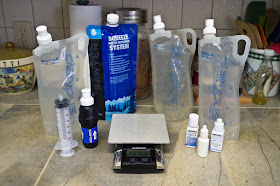 Hikers use a variety of simplified formulas to determine how much food one needs to pack for a given time or distance to meet 4500-6500 calories per day requirements, depending on age, gender, level of effort, temperature ...
Hikers use a variety of simplified formulas to determine how much food one needs to pack for a given time or distance to meet 4500-6500 calories per day requirements, depending on age, gender, level of effort, temperature ...NOLS developed their PPPPD (Pounds per person per day) formula for expedition planning. Their experience showed that backpackers need 1.4 to 2.0 PPPPD depending on all those variables.
Garlic08 on Whiteblaze.net figures 1 lb per 10 miles. If the next resupply point is 50 miles away, pack out 5 lbs. Whether you bang out the distance in 3 days, or stretch it out to 6 days you'd theoretically have the food to support the level of effort. Ymmv.
But that's not really what this post is about. What it's really about after the break.




